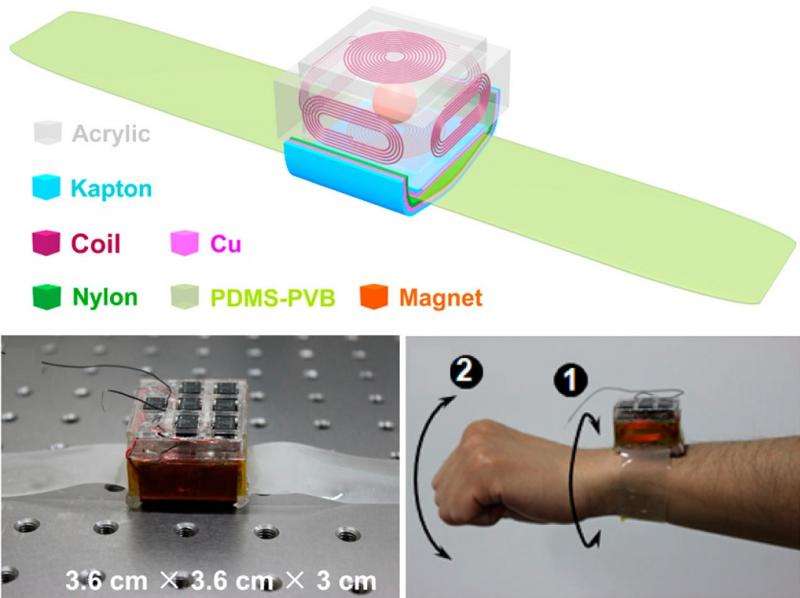November 23, 2015 feature
Self-powered e-watch is powered completely by wrist movements

(Phys.org)—Researchers have created a self-powered electronic watch that harvests energy from the wearer's wrist movements for continuous operation. By combining two different energy conversion mechanisms (electromagnetic and triboelectric) in a single hybrid nanogenerator, the device can harvest significantly more energy than previous harvesters that use only a single mechanism.
The scientists, led by Ya Yang at the Beijing Institute of Nanoenergy and Nanosystems in China, and Zhong Lin Wang at the Georgia Institute of Technology in the US, have published a paper on the hybrid nanogenerator in a recent issue of ACS Nano.
"This kind of nanogenerator can also be utilized to power other wearable electronic devices, such as a wireless smart pedometer for reading data on walking steps, distance, and energy consumption," Yang told Phys.org.
The hybrid nanogenerator consists of a small box (3.6 cm x 3.6 cm x 3 cm) with a magnetic ball inside. When the wearer moves their wrist, the ball's motion generates electricity by both the electromagnetic and triboelectric effects. Due to the electromagnetic effect, when the ball collides with six metal coils on the sides of the box, the ball's mechanical energy is converted into electricity.
The triboelectric effect occurs when two materials are rubbed together, similar to how rubbing a balloon on a person's hair creates static electricity. Here, the watch strap serves as the triboelectric component. The strap is made of two materials with different triboelectric polarities, nylon and a polymer composite, which are attached to the bottom of the box and to two electrodes. When the moving magnetic ball presses down on the watch strap, the nylon and polymer come in contact with each other, generating triboelectric charges and causing electrons to flow between the electrodes.
The researchers experimented with the way that different wrist movements can charge and power the watch. They found that the best wrist movement is a twisting motion that can generate a current of up to 12 mA, which means that thirty-nine seconds of this twisting motion can power the watch continuously for about 7.5 minutes. By adding a homemade Li-ion battery to store the energy produced by the hybridized nanogenerator, the researchers found that 32 minutes of the twisting motion can generate enough energy to continuously power the watch for more than 3.5 hours. Based on this data, the researchers calculated that 3.6 hours of wrist movement can generate enough energy to power the watch for one day of continuous operation.
Since the current prototype is rather large in size, the researchers attempted to reduce the dimensions by replacing the magnetic ball with a thin magnetic sheet. However, they found that the magnetic sheet does not move as easily as the ball, and so in the future they plan to investigate other methods of miniaturizing the nanogenerator. They also hope to eliminate the need for the battery.
"The future plan is to solve the power source issue of the wearable electronic device, so that these devices can work sustainably without being charged by the external power source," Yang said. "Ideally, the motion of human-body-induced energy will be enough to power these devices."
More information: Ting Quan, et al. "Hybridized Electromagnetic–Triboelectric Nanogenerator for a Self-Powered Electronic Watch." ACS Nano. DOI: 10.1021/acsnano.5b05598
Journal information: ACS Nano
© 2015 Phys.org




















